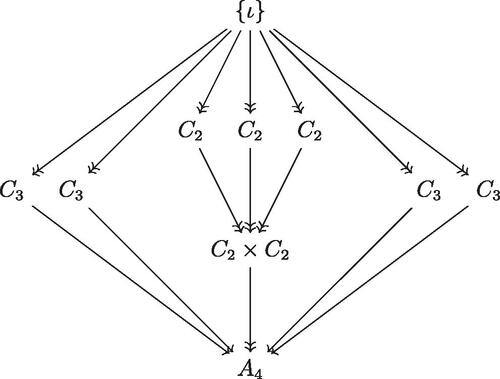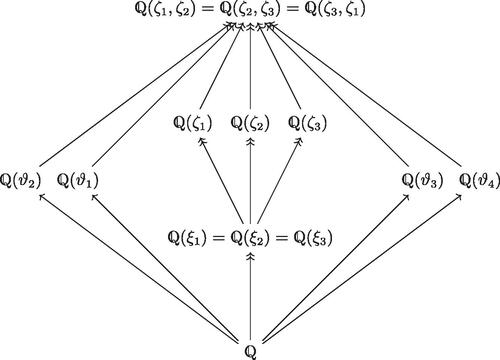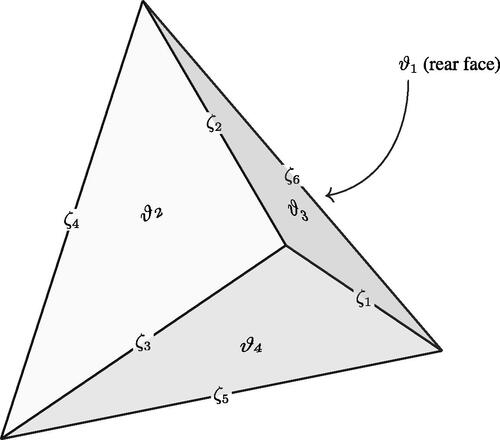 ?Mathematical formulae have been encoded as MathML and are displayed in this HTML version using MathJax in order to improve their display. Uncheck the box to turn MathJax off. This feature requires Javascript. Click on a formula to zoom.
?Mathematical formulae have been encoded as MathML and are displayed in this HTML version using MathJax in order to improve their display. Uncheck the box to turn MathJax off. This feature requires Javascript. Click on a formula to zoom.Abstract
Let and let
be the splitting field of f over
. We show by hand that the Galois group
of the Galois extension
is isomorphic to the alternating group A4. Moreover, we show that the six roots of f correspond to the six edges of a tetrahedron and that the four roots of the polynomial
correspond to the four faces of a tetrahedron, which allows us to determine all eight proper intermediate fields of the extension
.
1 Introduction
Teaching Galois theory, one often has the problem that the Galois group of a field extension of is either quite simple or too difficult to be computed by hand. An example of a Galois group which is isomorphic to the dihedral group of order 8 can be found in Stewart [Citation1, Ch. 13]. Introducing this example, Stewart writes that this Galois group has an “archetypal quality, since a simpler example would be too small to illustrate the theory adequately, and anything more complicated would be unwieldy” [Citation1, p. 155]. Moreover, it is usually rather tedious to compute the Galois group along with the intermediate fields and their relations.
The aim of this note is to provide a worked out field extension over whose Galois group is isomorphic to the alternating group A4 (i.e., to the symmetry group of the tetrahedron), and to compute by hand all intermediate fields and their relations. If we do not require that the ground field is
, a canonical way to obtain a field extension L/K with
for some fields
, is to start with a polynomial
of degree 4 such that the Galois group of the field extension
—where L is the splitting field of f over
—is isomorphic to the symmetry group S4. Then, since
, by the Galois correspondence we find a quadratic extension K of
such that
(see also Osofsky [2, p.222]). However, since the ground field K of the field extension L/K is already a field extension of
, it is quite exhausting to compute
and the intermediate fields of L/K by hand.
Before we present our example in the next section, we set up the terminology (according to [Citation1, Citation3]), where we assume that the reader is familiar with the basic facts of Galois theory with respect to field extensions over .
If is a polynomial, then the smallest subfield of
containing all of the roots of f is called the splitting field of f over
. The splitting field of f over
is unique up to isomorphism. If
is a field extension and
is a field, then M is called an intermediate field of
. If
are fields, then the group of all automorphisms of L which fix M point-wise is the Galois group of the field extension L/M, denoted
. Let
be a polynomial,
its splitting field over
, and M an intermediate subfield, so
. Let
and let
be its splitting field over M. Then
is a Galois extension. We will only consider Galois extensions of this type.
Now we can state the main theorem of Galois theory.
The Galois Correspondence. Let be an arbitrary Galois extension. Then the following holds:
To each subgroup
there exists an intermediate field LH, such that
For each intermediate field
we have
and
Let M1 and M2 be intermediate fields of some field extension
, and let
. If, for some
, we have
, then the fields M1 and M2 are conjugate.
If
is such that
is a normal subgroup of
(i.e., the conjugate class of M contains only M), then the field extension
is Galois and
2 A field extension 
 with
with 

We start with the polynomial and consider its splitting field
over
. The goal is to show that
, where A4 is the alternating group of degree 4, which is isomorphic to the symmetry group of the tetrahedron.
In order to compute the roots of f, we replace X2 by ξ and first compute the roots of the irreducible polynomial . To see that g is irreducible, consider the polynomial
By the Eisenstein-Schönemann Criterion (with p = 3), we see that is irreducible over
, and so is g.
Observe that every complex number can be written as
with
. Indeed, for
we have
and hence
This is a quadratic equation for with a solution if
. In particular, a root ξ of g can be written in the form
with
. Then
So, since , we have
and since
, we obtain
If we set , then
and hence
. We choose the solution
Now α is a third root of z1 and we choose . Since
, we obtain
Then
which shows that ξ1 is indeed a root of
. The two remaining third roots of z1 are
Hence the roots of g are given by
Thus, , which shows that
,
, and
.
Notice that
and similarly we have . Thus we have
Similarly we get and
. This shows that
. In particular,
is the splitting field of g over
. So, for
, the field extension
is Galois.
For convenience in later arguments, we rewrite the three roots of g as follows:
Then by construction we obtain the six pairwise distinct roots of f as for
. In particular, we define
This shows that
Notice that since , we have
, which implies that the product
. Moreover, by definition of
we have
.
Now, let us show that f is irreducible over . For this, assume on the contrary that
for some nonconstant polynomials
. If
, e.g.,
, then
, which is obviously a contradiction. Assume now that
, e.g.,
or
. Then, in the former case this would imply
, and in the latter case this would imply
. Thus in both cases we arrive at a contradiction. If
and p is of the form
then
, which is again a contradiction. Finally, if
and p is of the form
then q is of the form
Since , we must have
and
. In particular,
and therefore
, but since
for all
, we conclude that
. Thus, there are no nonconstant polynomials
such that
, which shows that f is irreducible over
. In particular, since
is a monic, irreducible polynomial of degree 6 with the six roots
, we have
for
and
.
Let and
, where
and Lg are the splitting fields of f and g, respectively. Then, since
and
, we have
and therefore
, where Cn denotes the cyclic group of order n. Furthermore, since the field extension
is Galois,
and
. Since
,
is not the trivial group.
Now, we consider . Let
. Then
for
. Thus
for all
. To see this, consider, for example,
. Therefore
.
If we adjoin to the field Lg a root ζm (for ), then we obtain the intermediate field
, where
. Since
for some
and
, we have
. Since each of the fields
(for
) is the splitting field of a quadratic polynomial of the form
for
, each of the field extensions
(for
) is Galois with
.
Now, there are three possible intermediate fields of the form , namely
, and
. To see that these three intermediate fields are pairwise distinct, notice first that, since
, we have
, and therefore
. Furthermore, if
, then, since
, we can write
Thus, , which is not the case. Similarly,
. Furthermore, if
, then with
we would have
, which is not the case.
To summarize, for we have
, and from
we obtain that
. In particular we have that
is not cyclic.
Finally, we show that for any distinct i and j with
. To see this, recall that
, which implies that we can compute, for example, ζ2 from ζ1 and ζ3. Now, since
, which implies
, and since
for all
, we conclude that
for all
. Furthermore, since ζj is a root of
and
, we have
. In particular,
.
Now, we are ready to show that . Since
, every element
corresponds to a permutation of
, where the elements
(i.e., the elements
) are permuted cyclically. By the observations above, every
can be written as
for
,
, and
, where, in cycle notation,
and for
,
Since ρ corresponds to a cyclic permutation of , we have
, and since for
we have
. So, since
, we get that for any pairwise distinct
, if
and
, then
(i.e., l = k), which corresponds to the fact that
.
Let us now consider a tetrahedron T with the six edges ①, ②, ③, ④, ⑤, ⑥, where the pairs of edges (①, ④), (②, ⑤), and (③, ⑥) are opposite edges of T. If we identify the six edges ①, …, ⑥ with the six roots of f, then every element
corresponds to an element of the symmetry group of the tetrahedron T, i.e., to an element of the alternating group A4 (this fact is visualized by at the end of the next section).
3 Subgroups and Intermediate Fields
illustrates all subgroups of A4. For some of these subgroups of A4, we already found the corresponding intermediate fields. In particular, we found that the field that corresponds to is
, and since
is a normal subgroup of A4, we obtain that
. Furthermore, the three fields which correspond to the subgroups C2 are
, and
. Notice that these three fields are pairwise conjugate. To see this, let
and let, for example,
be such that
,
. Then
which shows that the automorphism
fixes ζ2, i.e.,
is an element of
.
Fig. 1 Subgroup Diagram of . For two groups H and G, an arrow
or
indicates that H is a subgroup or a normal subgroup of G; and ι denotes the identity automorphism of
.

In order to find the four intermediate fields Mi (for ) with
, we proceed as follows. First, we identify
with the numbers
and the elements of the group A4 with a subgroup of S6 (i.e., the symmetry group of
). Furthermore, let, again in cycle notation,
be the four subgroups of A4 which are isomorphic to C3. Then, the four intermediate fields Mi are the four fixed-fields
Let , be defined as follows:
It is not hard to verify that for each . For example, consider the element
. Then
which shows that
. Furthermore, we can verify that for
we have
which shows that the four intermediate fields are pairwise conjugate. For example, let
. Then
and we have
which shows that
. Moreover, we get that
which shows that π is a cyclic permutation of
, and
.
illustrates all intermediate fields of the field extension .
Fig. 2 Diagram of intermediate fields. For two fields K and M, an arrow or
indicates that K is a subfield of M, and
indicates that the field extension is Galois.

Finally, we consider the polynomial . To keep the notation short, we introduce the following function: For integers a, b we define
by stipulating
and
for
. Then, since for
,
and
, and bearing in mind the identities
and for
,
we obtain
Since belong to Lh, where Lh is the splitting field of
over
, Lh is a subfield of Lf, and since
is a Galois extension,
and therefore
, which implies that
is isomorphic to either
, C3, or A4. We have seen above that there is a
which is a cyclic permutation of
, and similarly, we find a
which is a cyclic permutation of
. Hence
must be isomorphic to A4. In particular, the fields
and Lh are isomorphic.
Let us consider again the tetrahedron T with the six edges , where the pairs of edges
(for
) are opposite edges of T. We already know that the group
is isomorphic to the symmetry group of the tetrahedron acting on its six edges. We show now that
is isomorphic to the symmetry group of the tetrahedron acting on its four faces. For this, we identify the four faces of the tetrahedron with the four roots
of h as illustrated in .
Fig. 3 The elements of and
act as congruence transformations of the tetrahedron on its edges and faces, respectively.

In order to see that the elements of the symmetry group of the tetrahedron correspond simultaneously to the elements of and
, respectively, we consider two elements of the symmetry group of the tetrahedron.
First, let ρ1 be the rotation by the angle π about the axis joining the midpoints of the edges ζ1 and ζ4. Then ρ1 acts on the edges and the faces of the tetrahedron as follows:
and
Notice that the intermediate field which corresponds to ρ1 is .
Second, let ρ2 be the rotation by the angle about the axis joining the center of the face
with the opposite vertex. Then ρ2 acts on the edges and the faces of the tetrahedron as follows:
and
Notice that the intermediate field which corresponds to ρ2 is .
Conclusion
What we have achieved is a visualization of a Galois group in terms of the edges and faces of a tetrahedron. In particular, we found two polynomials f and h of degree six and four, respectively, such that the roots of f correspond to the six edges and the roots of h correspond to the to the four faces (or vertices) of the tetrahedron. Moreover, since we were able to carry out all the calculations by hand, we obtained a complete understanding of the field extension , and in addition, we have an illustrative example of a Galois extension that shows the power and beauty of Galois theory.
Acknowledgment
We would like to thank the referees for their valuable remarks and comments.
Disclosure statement
No potential conflict of interest was reported by the authors.
Additional information
Notes on contributors
Lorenz Halbeisen
LORENZ HALBEISEN received his Ph.D. in mathematics from ETH Zürich in 1994. He has been a lecturer at Queen’s University Belfast and at the University of Zürich, and since 2022 he is professor at the ETH Zürich. He likes all kinds of puzzles and mathematical problems with a combinatorial flavor.
Department of Mathematics, ETH Zentrum, Rämistrasse 101, 8092 Zürich, Switzerland
Norbert Hungerbühler
NORBERT HUNGERBÜHLER received his Ph.D. in mathematics from ETH Zürich in 1994. He has been a professor at UAB in Birmingham, Alabama, at the University of Fribourg, and since 2010 at ETH Zürich. He likes to combine different areas of mathematics and to look at familiar things from a new viewpoint.
Department of Mathematics, ETH Zentrum, Rämistrasse 101, 8092 Zürich, Switzerland
References
- Stewart I. Galois theory. 4th ed. New York: Chapman & Hall/CRC; 2015. doi: 10.1201/b18187.
- Osofsky BL. Nice polynomials for introductory Galois theory. Math Mag. 1999;72(3):218–222. doi: 10.1080/0025570X.1999.11996733.
- Morandi P. Field and Galois theory. New York: Springer; 1996. (Graduate texts in mathematics; vol. 167). doi: 10.1007/978-1-4612-4040-2.
